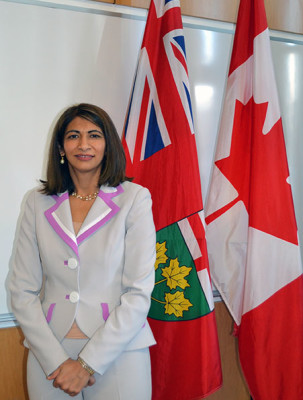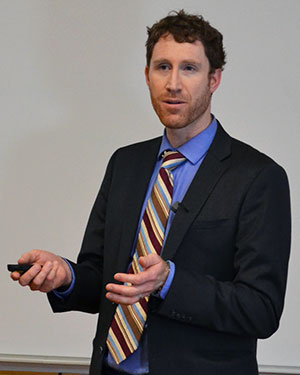MPP educates community at Tuition Town Hall

MPP Dipika Damerla answers questions about the Ontario Student Grant during a Tuition Town Hall at Sheridan’s Hazel McCallion Campus. (Photography By: Elise Morton/The Sheridan Sun)
BY ELISE MORTON
A Tuition Town Hall held at Sheridan’s Hazel McCallion Campus on March 16 gave the community an opportunity to ask MPP Dipika Damerla questions and learn more about the Ontario Student Grant (OSG).
Around 50 people including students, parents, community members and reporters who were eager to have their questions answered attended the event.
As part of the proposed 2016 provincial budget the OSG would provide enough grant money for students from low-income families making under $50,000 to have free tuition.
“I think our plan right now is to make tuition affordable,” said Damerla. “By affordable, I mean that no child doesn’t go to school because of the price. We want to be able to give them all the aid and support they will need to be able to go.”
According to Damerla, statistics show that there’s an 80 per cent chance a child from a family with a combined income of more than $180,000 will go to college or university. This probability drops to 30 per cent for a child from a family with a combined low-income of about $40,000.
“That difference between 30 and 80 per cent is not because of ability or intelligence, it’s simply a matter of family income and that’s not fair,” said Damerla. “The changes that we have announced means that 150,000 students in Ontario will get their tuition virtually free on average and another 170,000 students will pay less than what they are paying.”
In addition to the tuition changes, the budget also affects the Ontario Student Assistance Program (OSAP), which provides multiple loans and grants to help students with their post-secondary costs.
MORE RELATED TO THIS STORY:
- Flynn calls free tuition ‘ingenious’ at Sheridan announcement
- The rising cost of tuition in Canada
- Provincial budget talks met with protest in Hamilton
“In Ontario we have a very generous system of providing aid and grants to low-income families, but the problem is it’s very confusing and families don’t know that we have it,” said Damerla.
The government is combining all of the 20 loans and grants that students can potentially apply for under OSAP to create one major grant, the OSG, which will be easier for anyone to qualify for.
To provide the audience with more details about the changes that will occur in OSAP, Damerla brought Graham Webster, manager of the Student Financial Assistance Program at Ontario’s Ministry of Training, Colleges and Universities with her to HMC.

Graham Webster provides details about the new changes to OSAP proposed in the 2016 provincial budget. (Photography By: Elise Morton/ The Sheridan Sun)
According to Webster, around 380,000 students benefit from the multiple OSAP grants and loans each year. In Ontario, this equals around 60 per cent of full-time university and 70 per cent of full-time college students.
Although OSAP provided around $3.5 billion to help full-time Ontario students with their school fees in 2014-2015, Webster believes the current system has some problems that need to be fixed.
“Mature learners aren’t appropriately helped, but there are a lot of grants available for young students,” said Webster. “Students got some of the grant upfront and during another part of the year, but we are planning to provide all the money upfront, so when you get the bill you know exactly what you owe.”
Curious to learn what would be available to him, Ahsan Khokhar a fourth-year Political Science student at York University found that he learned what he wanted, but felt the presentation needed more.
“I believe this change will largely impact students parents making less than $50,000, but there won’t be a large increase in the grants for families making $80,000,” said Khokhar. “The one thing with her presentation that was wrong was it was very vague and broad and there was nothing really in detail.”
According to Damerla, there will be a final vote in the next month to determine if the budget should pass and if the OSG and changes will be implemented at the start of the school year in 2017-2018.
“The two main messages that we want students to know is that we are simplifying the process and a lot of people are going to pay less than they paid before,” said Damerla.




